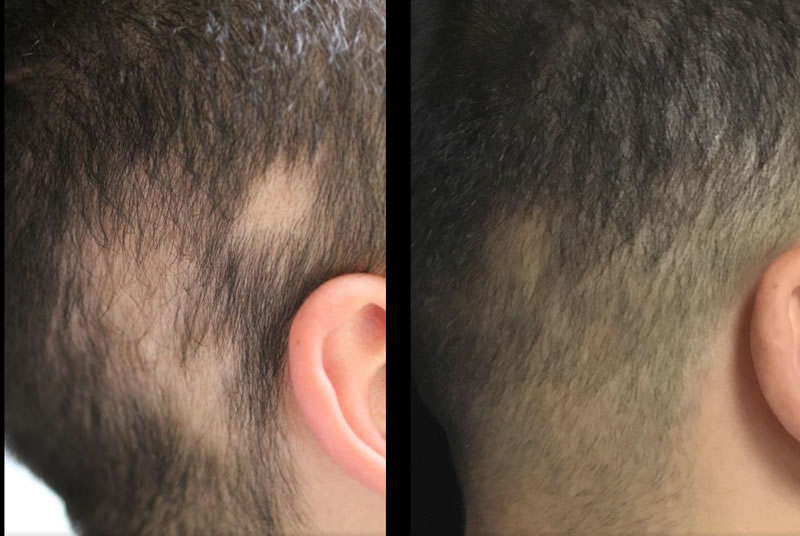Hair Loss Alopecia: Causes, Symptoms, and Regrowth Options
Table Of Content

DermNet does not provide an online consultation service. If you have any concerns with your skin or its treatment, see a dermatologist for advice. DermNet does not provide an online consultation service.If you have any concerns with your skin or its treatment, see a dermatologist for advice.
FDA Approves First Systemic Treatment for Alopecia Areata
The course of alopecia areata varies from person to person. Some have bouts of hair loss throughout their lives, while others only have one episode. Recovery is unpredictable too, with hair regrowing fully in some people but not others.
Prevention
The most common Alopecia type is Androgenetic Alopecia, otherwise known as Genetic Hair Loss or Female Pattern Hair Loss which accounts for half of hair loss cases for women. Male-pattern or female-pattern baldness can occur when anabolic steroids are used. Chemotherapy medications typically cause disruption of the growing phase that causes loss of anagen hairs (anagen effluvium). Most types of alopecia develop without warning and progress at an unpredictable rate.
What is baldness?
Hair loss may begin on the beard instead of the scalp. This hair loss may be patchy (A) or cause a well-defined bald spot (B). This patch is often the first sign of alopecia areata.
People living with alopecia areata have options when it comes to managing their condition — although there isn’t a one-size-fits-all approach. You might need to try a few treatments before finding one that works for you. While this hair loss might not be noticeable at first, if you experience multiple instances of hair loss, the areas of alopecia areata may join together and become more visible. Sometimes alopecia or hair loss in children can be quite normal.
HopeMed advances its androgenetic alopecia treatment to Phase II trials - Clinical Trials Arena
HopeMed advances its androgenetic alopecia treatment to Phase II trials.
Posted: Mon, 15 Jan 2024 08:00:00 GMT [source]
Topical anthralin
Apart from medications, there are other things you can try if you have alopecia areata. To treat these changes in an adult, a dermatologist may prescribe medication like a corticosteroid or tazarotene, which you apply to the nails. Another option is to inject the changed nails with a corticosteroid or prescribe corticosteroid pills for a short time. Use these professionally produced online infographics, posters, and videos to help others find and prevent skin cancer. Your nails may also develop dents or pits (cupuliform depressions).
Hair loss can occur if you wear pigtails, braids or cornrows, or use tight hair rollers. It’s important to talk with a doctor before trying any new treatment, since many cause side effects. We also consulted medical studies and resources to corroborate information about each treatment. Keep reading to learn about the most popular ways to treat alopecia areata.
These may include family history, other autoimmune conditions, skin conditions, and more. However, it’s not always possible to predict who will develop alopecia, which makes preventing it difficult. Doctors often prescribe oral medications to be used along with topical minoxidil because studies show the combination boosts hair production. Low-dose oral minoxidil (prescribed off-label) has been found to be effective and safe for most patients, Mirmirani says. Other oft-used drugs include finasteride (Propecia) and spironolactone.
I want to get healthier
Some people think it may be triggered by a viral infection,” she says. Last night at the Oscars, Will Smith slapped Chris Rock after the comedian made a joke at the expense of Smith’s wife, Jada Pinkett Smith, who is experiencing hair loss. The word menopause refers to the last or final menstrual period. When a woman has had no periods for 12 consecutive months, she is considered to be postmenopausal.
In addition to hair loss, children may experience nail changes such as pitting or lesions. Adults may experience nail symptoms, too, but they are likely more common in children. When children develop this condition, it’s known as early onset alopecia areata. Keep reading to learn more about the types, causes, symptoms, and treatments for alopecia areata. These are anti-inflammatory drugs that are prescribed for autoimmune diseases. They can be given as an injection into the scalp or other areas.
Numerous therapies have been used with variable response and high quality evidence is lacking. Alopecia areata is typically diagnosed on clinical features, however additional tests may aid diagnosis. AARP is a nonprofit, nonpartisan organization that empowers people to choose how they live as they age.
Traction alopecia is hair loss caused by tight braids, rollers, or ponytails that pull constantly on hair. Hair loss most often occurs at the hairline of the forehead and temples. At the end of the resting phase, the hair falls out (exogen), and the cycle begins again as a new hair starts growing in the follicle. Normally, about 50 to 100 scalp hairs reach the end of resting phase each day and fall out. The interest in hair replacement has gone up over the past several years.
Comments
Post a Comment